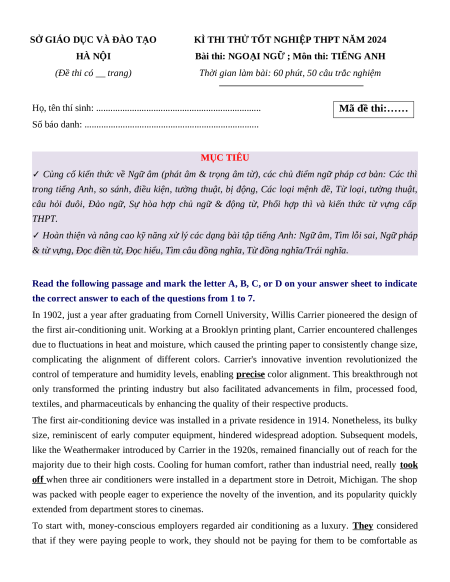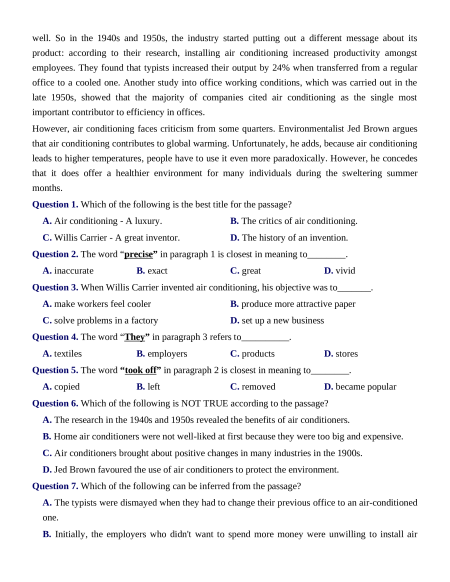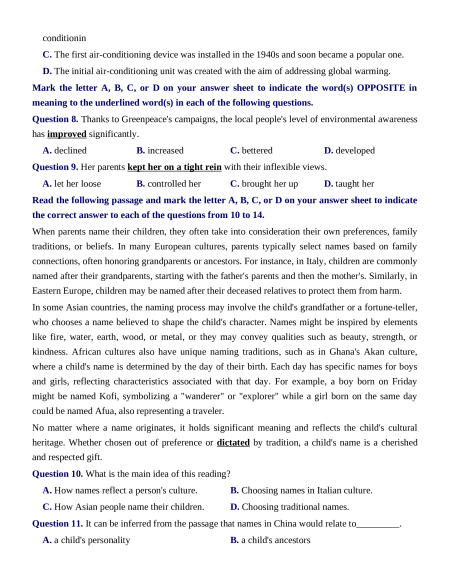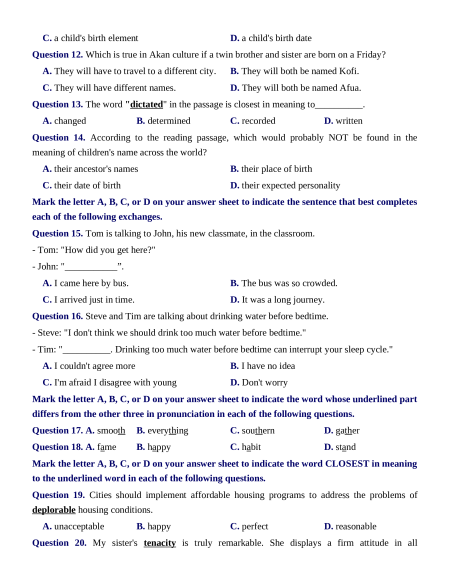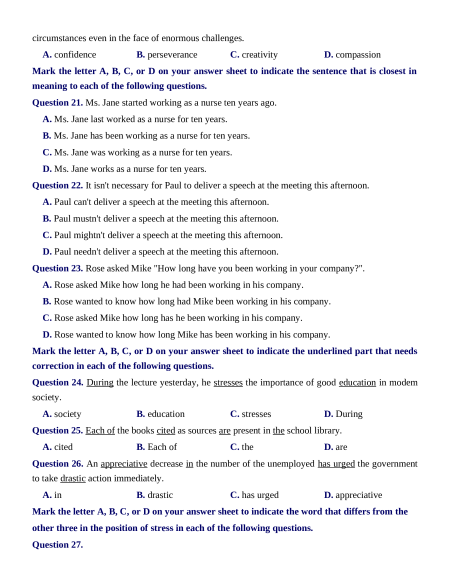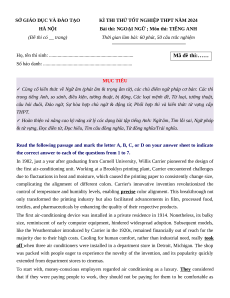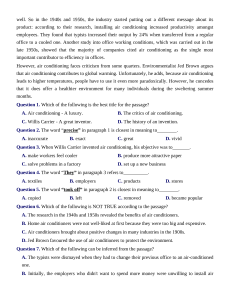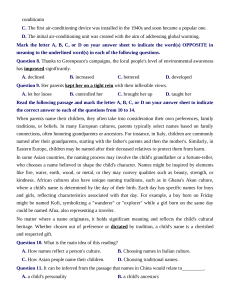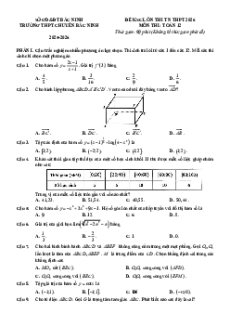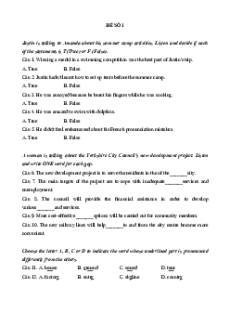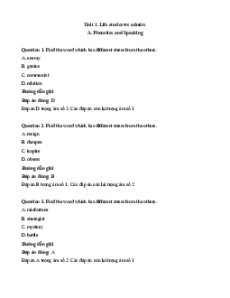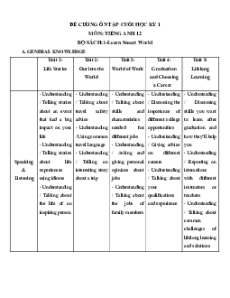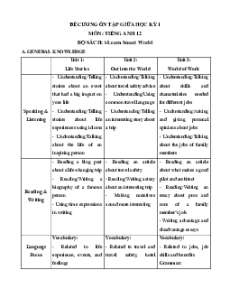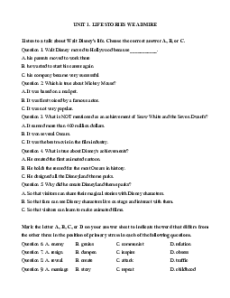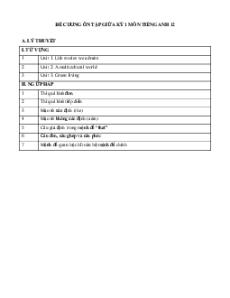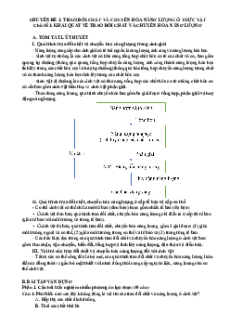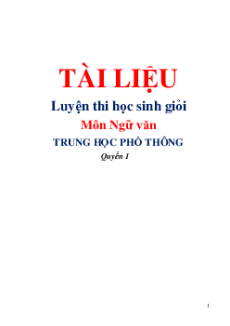SỞ GIÁO DỤC VÀ ĐÀO TẠO
KÌ THI THỬ TỐT NGHIỆP THPT NĂM 2024 HÀ NỘI
Bài thi: NGOẠI NGỮ ; Môn thi: TIẾNG ANH
(Đề thi có __ trang)
Thời gian làm bài: 60 phút, 50 câu trắc nghiệm
Họ, tên thí sinh: ..................................................................... Mã đề thi:……
Số báo danh: ......................................................................... 1 MỤC TIÊU
✓ Củng cố kiến thức về Ngữ âm (phát âm & trọng âm từ), các chủ điểm ngữ pháp cơ bản: Các thì
trong tiếng Anh, so sánh, điều kiện, tường thuật, bị động, Các loại mệnh đề, Từ loại, tường thuật,
câu hỏi đuôi, Đảo ngữ, Sự hòa hợp chủ ngữ & động từ, Phối hợp thì và kiến thức từ vựng cấp THPT.
✓ Hoàn thiện và nâng cao kỹ năng xử lý các dạng bài tập tiếng Anh: Ngữ âm, Tìm lỗi sai, Ngữ pháp
& từ vựng, Đọc điền từ, Đọc hiểu, Tìm câu đồng nghĩa, Từ đồng nghĩa/Trái nghĩa.
Read the following passage and mark the letter A, B, C, or D on your answer sheet to indicate
the correct answer to each of the questions from 1 to 7.
In 1902, just a year after graduating from Cornell University, Willis Carrier pioneered the design of
the first air-conditioning unit. Working at a Brooklyn printing plant, Carrier encountered challenges
due to fluctuations in heat and moisture, which caused the printing paper to consistently change size,
complicating the alignment of different colors. Carrier's innovative invention revolutionized the
control of temperature and humidity levels, enabling precise color alignment. This breakthrough not
only transformed the printing industry but also facilitated advancements in film, processed food,
textiles, and pharmaceuticals by enhancing the quality of their respective products.
The first air-conditioning device was installed in a private residence in 1914. Nonetheless, its bulky
size, reminiscent of early computer equipment, hindered widespread adoption. Subsequent models,
like the Weathermaker introduced by Carrier in the 1920s, remained financially out of reach for the
majority due to their high costs. Cooling for human comfort, rather than industrial need, really took
off when three air conditioners were installed in a department store in Detroit, Michigan. The shop
was packed with people eager to experience the novelty of the invention, and its popularity quickly
extended from department stores to cinemas.
To start with, money-conscious employers regarded air conditioning as a luxury. They considered
that if they were paying people to work, they should not be paying for them to be comfortable as
well. So in the 1940s and 1950s, the industry started putting out a different message about its
product: according to their research, installing air conditioning increased productivity amongst
employees. They found that typists increased their output by 24% when transferred from a regular
office to a cooled one. Another study into office working conditions, which was carried out in the
late 1950s, showed that the majority of companies cited air conditioning as the single most
important contributor to efficiency in offices.
However, air conditioning faces criticism from some quarters. Environmentalist Jed Brown argues
that air conditioning contributes to global warming. Unfortunately, he adds, because air conditioning
leads to higher temperatures, people have to use it even more paradoxically. However, he concedes
that it does offer a healthier environment for many individuals during the sweltering summer months.
Question 1. Which of the following is the best title for the passage?
A. Air conditioning - A luxury.
B. The critics of air conditioning.
C. Willis Carrier - A great inventor.
D. The history of an invention.
Question 2. The word “precise” in paragraph 1 is closest in meaning to________. A. inaccurate B. exact C. great D. vivid
Question 3. When Willis Carrier invented air conditioning, his objective was to_______.
2 A. make workers feel cooler
B. produce more attractive paper
C. solve problems in a factory
D. set up a new business
Question 4. The word “They” in paragraph 3 refers to__________. A. textiles B. employers C. products D. stores
Question 5. The word “took off” in paragraph 2 is closest in meaning to________. A. copied B. left C. removed D. became popular
Question 6. Which of the following is NOT TRUE according to the passage?
A. The research in the 1940s and 1950s revealed the benefits of air conditioners.
B. Home air conditioners were not well-liked at first because they were too big and expensive.
C. Air conditioners brought about positive changes in many industries in the 1900s.
D. Jed Brown favoured the use of air conditioners to protect the environment.
Question 7. Which of the following can be inferred from the passage?
A. The typists were dismayed when they had to change their previous office to an air-conditioned one.
B. Initially, the employers who didn't want to spend more money were unwilling to install air conditionin
C. The first air-conditioning device was installed in the 1940s and soon became a popular one.
D. The initial air-conditioning unit was created with the aim of addressing global warming.
Mark the letter A, B, C, or D on your answer sheet to indicate the word(s) OPPOSITE in
meaning to the underlined word(s) in each of the following questions.
Question 8. Thanks to Greenpeace's campaigns, the local people's level of environmental awareness
has improved significantly. A. declined B. increased C. bettered D. developed
Question 9. Her parents kept her on a tight rein with their inflexible views. A. let her loose B. controlled her C. brought her up D. taught her
Read the following passage and mark the letter A, B, C, or D on your answer sheet to indicate
the correct answer to each of the questions from 10 to 14.
When parents name their children, they often take into consideration their own preferences, family
traditions, or beliefs. In many European cultures, parents typically select names based on family
connections, often honoring grandparents or ancestors. For instance, in Italy, children are commonly
named after their grandparents, starting with the father's parents and then the mother's. Similarly, in
Eastern Europe, children may be named after their deceased relatives to protect them from harm.
In some Asian countries, the naming process may involve the child's grandfather or a fortune-teller,
who chooses a name believed to shape the child's character. Names might be inspired by elements
like fire, water, earth, wood, or metal, or they may convey qualities such as beauty, strength, or
kindness. African cultures also have unique naming traditions, such as in Ghana's Akan culture,
where a child's name is determined by the day of their birth. Each day has specific names for boys
and girls, reflecting characteristics associated with that day. For example, a boy born on Friday
might be named Kofi, symbolizing a "wanderer" or "explorer" while a girl born on the same day
could be named Afua, also representing a traveler.
No matter where a name originates, it holds significant meaning and reflects the child's cultural
heritage. Whether chosen out of preference or dictated by tradition, a child's name is a cherished and respected gift.
Question 10. What is the main idea of this reading?
A. How names reflect a person's culture.
B. Choosing names in Italian culture.
C. How Asian people name their children.
D. Choosing traditional names.
Question 11. It can be inferred from the passage that names in China would relate to_________.
A. a child's personality
B. a child's ancestors3
C. a child's birth element D. a child's birth date
Question 12. Which is true in Akan culture if a twin brother and sister are born on a Friday?
A. They will have to travel to a different city.
B. They will both be named Kofi.
C. They will have different names.
D. They will both be named Afua.
Question 13. The word "dictated" in the passage is closest in meaning to__________. A. changed B. determined C. recorded D. written
Question 14. According to the reading passage, which would probably NOT be found in the
meaning of children's name across the world?
A. their ancestor's names B. their place of birth C. their date of birth
D. their expected personality
Mark the letter A, B, C, or D on your answer sheet to indicate the sentence that best completes
each of the following exchanges.
Question 15. Tom is talking to John, his new classmate, in the classroom. - Tom: "How did you get here?" - John: "___________”. A. I came here by bus.
B. The bus was so crowded.
C. I arrived just in time.
D. It was a long journey.
Question 16. Steve and Tim are talking about drinking water before bedtime.
- Steve: "I don't think we should drink too much water before bedtime."
- Tim: "__________. Drinking too much water before bedtime can interrupt your sleep cycle."
A. I couldn't agree more B. I have no idea
C. I'm afraid I disagree with young D. Don't worry
Mark the letter A, B, C, or D on your answer sheet to indicate the word whose underlined part
differs from the other three in pronunciation in each of the following questions.
Question 17. A. smooth B. everything C. southern D. gather Question 18. A. fame B. happy C. habit D. stand
Mark the letter A, B, C, or D on your answer sheet to indicate the word CLOSEST in meaning
to the underlined word in each of the following questions.
Question 19. Cities should implement affordable housing programs to address the problems of
deplorable housing conditions. A. unacceptable B. happy C. perfect D. reasonable
Question 20. My sister's tenacity is truly remarkable. She displays a firm attitude in all
Đề thi thử tốt nghiệp Tiếng Anh Sở Giáo Dục Hà Nội năm 2024
843
422 lượt tải
MUA NGAY ĐỂ XEM TOÀN BỘ TÀI LIỆU
CÁCH MUA:
- B1: Gửi phí vào TK:
1133836868- CT TNHH DAU TU VA DV GD VIETJACK - Ngân hàng MB (QR) - B2: Nhắn tin tới Zalo VietJack Official ( nhấn vào đây ) để xác nhận thanh toán và tải tài liệu - giáo án
Liên hệ ngay Hotline hỗ trợ: 084 283 45 85
Chúng tôi đảm bảo đủ số lượng đề đã cam kết hoặc có thể nhiều hơn, tất cả có BẢN WORD, LỜI GIẢI CHI TIẾT và tải về dễ dàng.
Để tải tài liệu gốc về máy bạn click vào nút Tải Xuống ở trên!
Thuộc bộ (mua theo bộ để tiết kiệm hơn):
- Bộ đề thi thử tốt nghiệp THPT Quốc gia môn Tiếng Anh năm 2024 từ các Trường/sở trên cả nước.
- File word có lời giải chi tiết 100%.
- Mua trọn bộ sẽ tiết kiệm hơn tải lẻ 50%.
Đánh giá
4.6 / 5(843 )5
4
3
2
1
Trọng Bình
Tài liệu hay
Giúp ích cho tôi rất nhiều
Duy Trần
Tài liệu chuẩn
Rất thích tài liệu bên VJ soạn (bám sát chương trình dạy)
